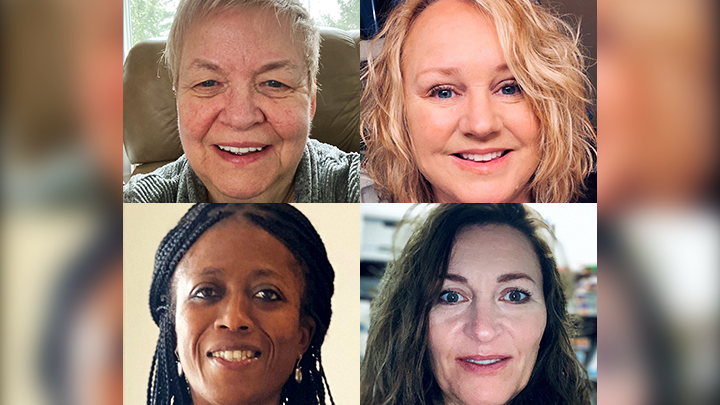
November 9, 2020

North Zone patient Val Blain (top left) solved an ostomy issue that had plagued her for more than 20 years with the help of Fort McMurray’s Michelle Sierink (top right), one of the Nurses Specialized in Wound, Ostomy and Continence (NSWOC) in the North Zone, who cares for patients in the eastern region. Other NSWOC nurses include Colette Smith (lower left), who’s based in Grande Prairie and serves the western region, while Michelle Rose (lower right), is based in Onoway and serves the central region.
Story by Diana Rinne
It’s not easy for Val Blain to talk about her ostomy. Like many who have a surgically-created opening (stoma) on the abdomen through which body waste material is collected in an exterior pouch, Blain keeps that part of her life rather private.
“It’s not a topic we discuss with everybody,” she says. “For those of us like myself, it’s a soft subject.”
But it’s a subject that needs to be talked about particularly when there are issues. For Blain and many others across the North Zone, that’s where Alberta Health Services Nurses Specialized in Wound, Ostomy and Continence (NSWOC) enter the picture.
The North Zone has three NSWOCs located in Fort McMurray, Onoway and Grande Prairie, each covering a wide area of the zone.
Michelle Rose is the NSWOC based in Onoway. She’s seen a lot of change since she began here back in 2009. “The need and types of patients we see has grown so much,” she says.
“When I started out in homecare in Onoway, I did have a few patients who struggled with ostomies and their only option was to go to back to Edmonton and they were waiting so long,” she adds.
Having specialized nurses like herself in the North Zone allows for patients to get the care they need in their own community, whether that be in person or through consultation with their regional NSWOC and local healthcare staff.
“Often, when I try to explain to people what I do, they think we just see elderly people and they don’t really understand,” says Rose. “Our patients can be very young to very elderly people. We see lots of patients with chronic wounds, which means their wounds have been there for quite a long time, or maybe healing hasn’t happened as expected.”
Michelle Sierink, who’s based in Fort McMurray, went back to school at age 48 to gain her NSWOC specialization when she saw how many people in her community struggle with their wound care and ostomies. “My biggest concern is for ostomy patients,” she says. “When they have issues, it really affects their lives. They don’t leave their homes.”
Colette Smith, based in Grande Prairie, was a staff nurse on a surgical ward when she decided to enter the NSWOC program. “Ostomy was definitely my first love, and that’s what got me into the program,” she says. She received her certification in 2003 and has served in her position since 2007.
While Sierink, Rose and Smith do in-person visits their respective communities, they also do a lot virtual consultations via phone and email due to the vast geography of the North Zone. Patients are referred to the three NSWOCs through Continuing Care Access (CCA), as well as by physicians, other healthcare professionals and self-referrals from patients with ostomy concerns.
“We look at photos and videos and talk with the patient and the nurse on hand,” says Sierink. “With ostomies, there are so many reasons why a person can have issues, so there are a lot of questions. We work with the patient to find out what’s going on. There‘s a lot of investigating.”
Collaboration with other healthcare professionals such as home care nurses, dietitians or occupational therapists is a big part of the job. For example, the home care team in St. Paul connected Blain with Sierink when she broke her shoulder and had concerns about how she would handle her ostomy.
“St. Paul home care nursing was the best bar none,” says Blain. “They are caring, compassionate and very helpful — and I’m a very shy person when it comes to my ostomy.”
Working with home care and Sierink, it was determined that one of Blain’s issues was an allergy to the glue used to keep her appliance in place.
“It was totally through the efforts of the home care personnel and my nurse (Sierink) that I was able to be completely cured of my allergy that I’d had for over 20 years,” she says.
“Having someone I can talk to — that I don’t have to feel uncomfortable talking to about this stuff — makes all the difference.”
Making that difference is easily one of the most satisfying parts of the job for all three nurses.
“It’s kind of funny how it can be so intense and you’re talking to patients daily,” says Rose. “And then, once things are better, you let them go on their own and you don’t hear from them. But they know if they have a problem, you’re there.”
Smith agrees: “It’s the patients. I’ve met so many wonderful people. Seeing someone from day one, and then you see them months later, or even sometimes years later, you don’t realize the impact that you’ve had on people at that point in their lives. It’s a privilege to be part of their journey.”
“Some say we’ve changed their lives,” adds Sierink. “We do change lives depending on how much the patient wants to be involved in their health. It’s really up to the patient to move forward.”